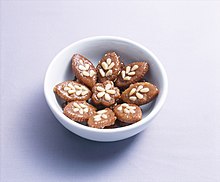Yumilgwa
Yumil-gwa
Korean dessert
Yumil-gwa (Korean: 유밀과; Hanja: 油蜜菓) is a variety of hangwa, a traditional Korean confection. Different varieties of yumil-gwa can be made by combining a wheat flour dough with various ingredients such as: honey, cooking oil, cinnamon powder, nuts, ginger juice, jujube, and cheongju (rice wine).[1]
 Yakgwa, a variety of yumil-gwa | |
| Place of origin | Korea |
|---|---|
| Associated cuisine | Korean cuisine |
| Yumil-gwa | |
| Hangul | 유밀과 |
|---|---|
| Hanja | 油蜜菓 |
| Revised Romanization | yumil-gwa |
| McCune–Reischauer | yumil-gwa |
| IPA | [ju.mil.ɡwa] |
The word yumil-gwa consists of three syllables: yu (유; 油) meaning "oil", mil (밀; 蜜) meaning "honey", and gwa (과; 菓) meaning "confection".
Yumil-gwa varieties have commonly been used and consumed for jesa (ancestral rites).[2]
During the Goryeo era (918–1392), yumil-gwa were offered during national feasts, rites, ceremonies, and banquets, including two Buddhist festivals, the Lotus Lantern Festival and the Festival of the Eight Vows.[3] In 1274, yumil-gwa varieties were used for pyebaek (formal greeting) in the wedding ceremony of King Chungnyeol and Princess Jeguk of Yuan China.[3] In 1296, yumil-gwa was brought to the wedding ceremony of the Crown Prince Won (later King Chungseon) and Princess Gyeguk of Yuan, China.[2]
Excessive use of yumil-gwa has led to the introduction of several regulations throughout history.[3] In 1117, King Sukjong issued a restriction on the extravagant usage of yumil-gwa.[3] In 1192, it was commanded that yumil-gwa had to be replaced with fruits. In 1353, a total ban was placed on yumil-gwa.[2] During the Joseon era (1392–1897), the use of yumil-gwa was restricted solely for rites, weddings, and toasts to longevity.[3]
Dough for yumil-gwa is made by kneading sifted wheat flour with sesame oil, honey, ginger juice, and cheongju (rice wine).[1] Additional ingredients for filling and garnishing may include cinnamon powder, honey, jujube, and pine nuts.[1] Deep-fried yumil-gwa is soaked in honey or jocheong (rice syrup), and dried.[1]
- Chasu-gwa (차수과; 叉手菓) is a hand-shaped yumil-gwa with five fingers.[4]
- Jungbaekki (중배끼), also called junggye (중계; 中桂), jungbakgye (중박계; 中朴桂), or junggye-gwa (중계과; 中桂菓), are rectangular yumil-gwa that are pan-fried before served.[5]
- Mandu-gwa (만두과; 饅頭菓) is deep-fried sweet dumplings.
- Maejap-gwa (매잡과; 梅雜菓), also called maejak-gwa (매작과; 梅雀菓) or tarae-gwa (타래과), is a ribbon-shaped yumil-gwa.
- Yakgwa (약과; 藥果), also called gwajul (과줄), is flower-shaped yumil-gwa made by molding and deep-frying sweet dough.
- Yohwa-gwa (요화과; 蓼花菓) is a yumil-gwa made into the shape of water-pepper flower.[6]
- Kwon, Yong-Seok; Kim, Young; Kim, Yang-Suk; Choe, Jeong-Sook; Lee, Jin-Young (2012). "An Exploratory Study on Kwa-Jung-ryu of Head Families". Journal of the Korean Society of Food Culture (in Korean). 27 (6): 588–597. doi:10.7318/kjfc/2012.27.6.588.
- 염, 초애. "Yumil-gwa" 유밀과. Encyclopedia of Korean Culture (in Korean). Academy of Korean Studies. Retrieved 8 June 2017.
- "yumil-gwa" 유밀과. Doopedia (in Korean). Doosan Corporation. Retrieved 8 June 2017.
- 이, 효지. "Chasu-gwa" 차수과. Encyclopedia of Korean Culture (in Korean). Academy of Korean Studies. Retrieved 18 August 2017.
- 황, 혜성. "Jungbaekki" 중배끼. Encyclopedia of Korean Culture (in Korean). Academy of Korean Studies. Retrieved 18 August 2017.
- 이, 효지. "Yohwa-gwa" 요화과. Encyclopedia of Korean Culture (in Korean). Academy of Korean Studies. Retrieved 18 August 2017.